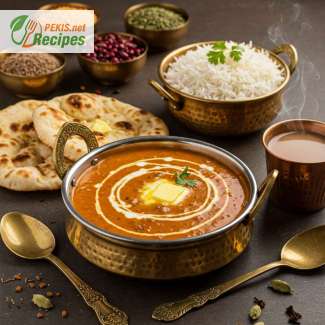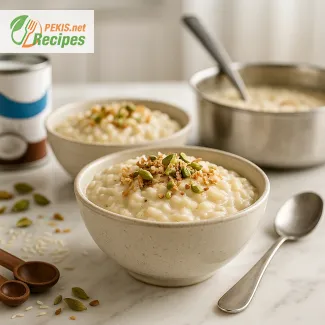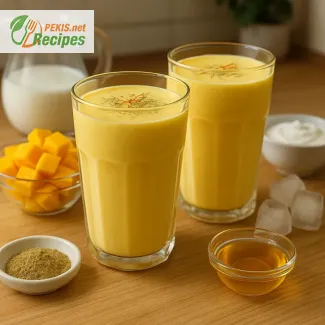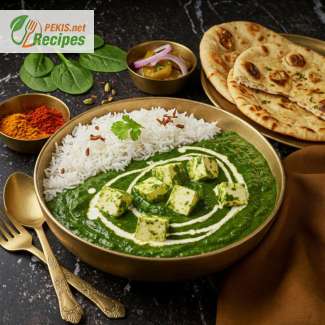
The Ultimate Guide to Making Restaurant-Style Dal Makhani at Home
A Taste of India’s Rich Culinary Heritage
Dal Makhani is more than just a dish; it is a culinary masterpiece that represents the essence of North Indian cuisine. With its creamy texture, rich aroma, and buttery smoothness, this beloved lentil dish has found its way onto tables across the world. Whether served in high-end restaurants or prepared lovingly in home kitchens, Dal Makhani stands as a symbol of indulgence and comfort food at its finest.
Originating from Punjab, this dish has a deep-rooted history, often associated with festive occasions, family gatherings, and the joy of sharing a hearty meal. The slow-cooked black lentils (urad dal) and red kidney beans (rajma) absorb the richness of aromatic spices, butter, and cream, resulting in a dish that is nothing short of a delight for the senses.
What Makes Dal Makhani So Special?
A Slow-Cooked Perfection
One of the key elements that make Dal Makhani truly exceptional is the long cooking process. Traditionally, the dish is slow-simmered for hours, allowing the flavors to develop deeply and blend harmoniously. The lentils break down to create a silky texture, while the combination of butter and cream ensures a luxurious finish.
The Perfect Balance of Spices
The magic of Dal Makhani lies in its perfectly balanced spice blend. Unlike other lentil dishes that rely on heavy seasoning, this dish uses a mild yet aromatic mix of spices such as cumin, coriander, garam masala, and a hint of dried fenugreek leaves (kasuri methi). The smoky undertones—often achieved through a traditional method called dhungar (coal smoking technique)—elevate the dish to a whole new level.
The Secret Ingredients for a Restaurant-Style Dal Makhani
To recreate restaurant-quality Dal Makhani, it’s important to understand the key ingredients that contribute to its depth of flavor and creamy consistency.
1. Black Lentils (Urad Dal) and Red Kidney Beans (Rajma)
These protein-rich legumes form the base of the dish. The slow cooking process breaks them down, making the curry thick and luscious.
2. Freshly Ground Spices
A combination of whole and ground spices provides an authentic taste. Bay leaves, cinnamon, cloves, and black cardamom infuse warmth, while garam masala and red chili powder add just the right amount of heat.
3. Tomato Puree and Butter
A rich tomato base gives Dal Makhani its signature tanginess, while a generous amount of butter enhances the creaminess. This combination ensures that the dish retains its silky smooth texture.
4. Cream for the Ultimate Indulgence
A final touch of cream is what transforms a good Dal Makhani into an exceptional one. It balances out the spice level and creates a velvety mouthfeel that lingers long after each bite.
Tips to Make the Best Dal Makhani
Soak the Lentils Overnight
To achieve the perfect consistency, soaking the lentils for at least 8 to 12 hours is crucial. This step helps in reducing cooking time while ensuring the lentils become soft and creamy when cooked.
Use Slow Cooking for Maximum Flavor
For the best results, simmer the dal on low heat for at least 1.5 to 2 hours. The longer the cooking time, the deeper the flavors develop. If possible, let it rest for a few hours before serving—it tastes even better the next day!
Don’t Skip the Butter and Cream
Dal Makhani is not just another lentil dish; it’s meant to be rich and indulgent. While you can adjust the butter and cream quantity to your preference, using high-quality dairy makes a noticeable difference in taste.
Infuse the Smoky Flavor
For an authentic touch, consider using the dhungar technique, where a piece of hot charcoal is placed in a bowl inside the pot of dal, and a few drops of ghee are added to create a rich, smoky aroma.
How to Serve Dal Makhani
Dal Makhani pairs beautifully with buttery naan, tandoori roti, or fragrant basmati rice. A side of pickled onions, fresh coriander, and a squeeze of lemon enhances the overall experience. Whether served as part of a lavish North Indian meal or enjoyed on its own, this dish promises to be a showstopper at any dining table.
A well-prepared Dal Makhani is the perfect balance of creamy, spicy, and smoky flavors. It is a dish that brings people together, offering a taste of India’s rich culinary tradition. Whether you are cooking for a special occasion or simply craving comfort food, this recipe guarantees a restaurant-style experience in the comfort of your home. So, gather your ingredients, embrace the slow-cooking process, and treat yourself to a bowl of authentic Dal Makhani—because some dishes are truly worth the time and effort!
- Soaking and Cooking the Lentils – Rinse black lentils and kidney beans under cold water. Soak them overnight (8-12 hours). Drain and rinse again before cooking.
- Boiling the Lentils – Add lentils and kidney beans to a pot with 1.2 L (5 cups) of water. Simmer on low heat for 1-1.5 hours until soft. Mash slightly for a creamy consistency.
- Preparing the Base – Heat butter in a pan. Add cumin seeds, followed by chopped onions, garlic, ginger, and green chili. Sauté until golden brown.
- Adding Tomatoes and Spices – Pour in tomato puree and cook until oil separates. Add turmeric, red chili powder, coriander powder, and salt. Mix well.
- Combining the Lentils – Add cooked lentils to the pan, stirring well. Simmer for 30-40 minutes on low heat, stirring occasionally.
- Finishing Touches – Add cream, dried fenugreek leaves, and garam masala. Stir well and let it cook for another 10 minutes.
- Serving – Garnish with fresh coriander and a drizzle of cream. Serve hot with naan or basmati rice.
Mastering Dal Makhani: Tips for Enhancing Flavor and Texture
Understanding the Essence of Dal Makhani
Dal Makhani is one of the most beloved dishes in Indian cuisine, renowned for its rich, creamy texture and bold yet balanced flavors. Originating from Punjab, this dish has gained global recognition, often served in restaurants as a luxurious lentil delicacy. However, making an authentic, restaurant-style Dal Makhani at home requires attention to detail, patience, and the right combination of ingredients.
While the traditional recipe consists of black lentils (urad dal), red kidney beans (rajma), butter, cream, and aromatic spices, there are several ways to refine and customize this dish to elevate its taste, texture, and presentation.
Choosing the Right Lentils and Beans
The Importance of High-Quality Ingredients
The foundation of Dal Makhani lies in the lentils and beans used. The most authentic and traditional choice is whole black lentils (urad dal), as they provide a naturally creamy texture when slow-cooked. Red kidney beans (rajma) add depth to the dish, ensuring a more complex flavor profile.
For the best results:
- Always use fresh lentils to avoid uneven cooking.
- Soak lentils and beans overnight (8-12 hours) to reduce cooking time and enhance digestibility.
- Slow cooking ensures the lentils break down naturally, creating the signature velvety consistency.
Substitutes for Lentils and Beans
If black lentils are unavailable, you can experiment with:
- Brown lentils – Similar but slightly milder in flavor.
- Green lentils – They hold their shape well but lack the creaminess of black lentils.
- Chickpeas (chana dal) – A different texture but adds a nutty depth to the dish.
Enhancing the Cooking Process
Slow Cooking for Maximum Flavor
One of the key elements that distinguish restaurant-style Dal Makhani from home-cooked versions is the slow-cooking process. Traditionally, this dish is simmered for hours, allowing the flavors to meld beautifully. If time permits, consider cooking it for at least 2-3 hours for a deep, rich taste.
For a quicker method, use a pressure cooker or Instant Pot, but let the dal simmer for at least 30 minutes after pressure cooking to enhance its texture.
The Secret to a Smoky Flavor
A unique way to add depth and complexity to Dal Makhani is by using the dhungar method—a charcoal smoking technique that infuses the dish with a subtle, smoky aroma.
To achieve this effect:
- Heat a small piece of charcoal until it turns red hot.
- Place it in a heatproof bowl inside the cooked dal.
- Pour a few drops of ghee (clarified butter) over the charcoal and immediately cover the pot with a lid.
- Let it sit for 5-7 minutes to absorb the smoky essence.
This method significantly enhances the restaurant-style authenticity of Dal Makhani.
Adjusting the Creaminess and Texture
Balancing Butter and Cream
The rich and creamy texture of Dal Makhani comes from butter and cream. However, the right balance is crucial—too much butter can make it greasy, while excessive cream might overpower the spice profile.
For a perfectly balanced dish:
- Use unsalted butter to control the salt levels.
- Add cream at the end of cooking to maintain its silky texture.
- For a lighter version, substitute heavy cream with Greek yogurt or coconut cream.
Achieving the Ideal Consistency
Dal Makhani should have a thick yet smooth consistency. If it becomes too thick, add a splash of warm milk or water while stirring continuously. If it’s too thin, let it simmer uncovered to allow excess moisture to evaporate.
Elevating the Spice Profile
Using Freshly Ground Spices
The spice blend in Dal Makhani should be aromatic and well-balanced. Freshly ground spices always yield a more intense flavor compared to store-bought versions. Key spices include:
- Cumin seeds – Enhances the earthy aroma.
- Coriander powder – Adds a subtle citrusy depth.
- Garam masala – A blend of warming spices that gives the dish its signature North Indian touch.
- Kasuri methi (dried fenugreek leaves) – Brings a slight bitterness that enhances the overall richness.
For an extra layer of complexity, add a pinch of nutmeg or a dash of cinnamon.
Adjusting Spice Levels
Dal Makhani is not overly spicy, but you can adjust the heat level to your preference:
- For milder flavors, reduce the red chili powder and add more cream.
- For a spicier kick, add finely chopped green chilies or a touch of smoked paprika.
Garnishing for a Beautiful Presentation
How you serve Dal Makhani can impact the overall dining experience. A well-garnished bowl enhances visual appeal and adds a burst of freshness.
Best garnishing options include:
- A drizzle of cream – Creates a striking contrast against the deep, rich color.
- Freshly chopped coriander – Adds brightness and a herbaceous touch.
- Thinly sliced ginger – Provides a mild heat and refreshing bite.
- A dollop of butter – Melts beautifully, adding an indulgent finish.
Perfect Pairings: What to Serve with Dal Makhani
Dal Makhani is incredibly versatile, pairing well with various Indian breads and rice dishes:
- Naan or buttered roti – The chewy texture complements the creaminess.
- Steamed or jeera rice – Fragrant basmati rice balances the richness.
- Lachha paratha – A flaky, buttery option for a satisfying meal.
For a complete North Indian feast, pair Dal Makhani with:
- Tandoori paneer tikka – A smoky and tangy contrast.
- Cucumber raita – A cooling yogurt-based side dish.
- Pickled onions and green chilies – Adds crunch and slight acidity.
Dal Makhani is a timeless classic, loved for its luxurious texture, comforting warmth, and robust flavors. While the traditional recipe remains a favorite, subtle changes in ingredients and techniques can elevate the dish to a whole new level.
By carefully selecting quality ingredients, slow-cooking for maximum flavor, and balancing the spices and richness, you can create an authentic, restaurant-quality Dal Makhani at home. Whether you prefer a classic preparation or a lighter, dairy-free variation, this dish promises to be a soul-satisfying culinary experience.
So, take your time, enjoy the process, and indulge in the rich, creamy, and smoky goodness of Dal Makhani!
- Contains dairy (butter, cream).
- Naturally gluten-free, but cross-contamination should be considered.
Substitutions for Allergens & Gluten-Free Options:
- Replace butter with vegan butter or ghee for a dairy-free option.
- Use coconut cream instead of heavy cream for a vegan alternative.
- Ensure all spices and lentils are labeled gluten-free if necessary.
- Vitamin A: 500 IU – Supports vision and immune function.
- Vitamin C: 10 mg – Enhances immune response and skin health.
- Calcium: 80 mg – Essential for bone health.
- Iron: 5 mg – Helps in oxygen transport in blood.
- Magnesium: 75 mg – Supports muscle and nerve function.
- Potassium: 600 mg – Regulates blood pressure and hydration.
- Lycopene (from tomatoes): Helps in reducing oxidative stress.
- Curcumin (from turmeric): Has anti-inflammatory and immune-boosting properties.
- Polyphenols (from lentils): Support heart health and lower cholesterol.





